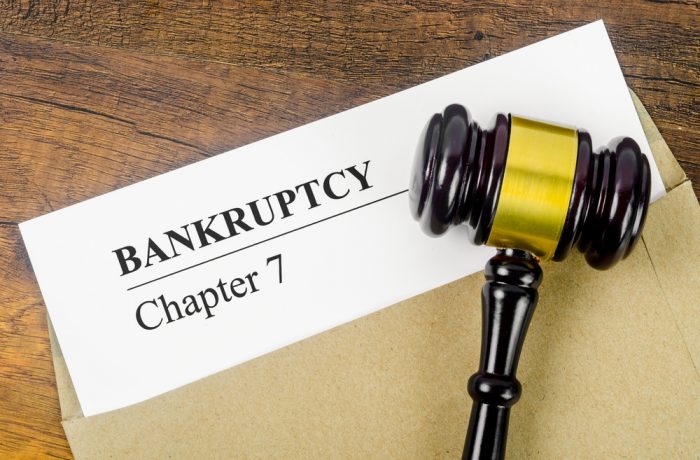By Brian Figeroux, Esq. | Editorial credit: Kmpzzz
The emotional impact of bankruptcy is profound, with many individuals experiencing shame, guilt, and anxiety. However, the Bible offers a framework for understanding bankruptcy as an act of forgiveness and grace, rather than failure. Through the Parables of Jesus and the Year of Release, we see that financial forgiveness is consistent with biblical principles. Read more at www.askthelawyer.us. To read the complete analysis in our publication, click here, and on our bankruptcy blog, click here.
Introduction
Bankruptcy is a deeply emotional process for many individuals. The decision to file often comes with intense feelings of shame, guilt, and anxiety. It can feel like a personal failure, but in reality, bankruptcy is a legal tool designed to help individuals restructure or eliminate debt and start fresh. Throughout history, financial failure has been associated with social and moral stigma, but this perspective overlooks key biblical teachings that speak to the forgiveness of debts and the grace offered to those in need of relief.
The Bible offers numerous examples of how forgiveness extends not only to moral failings but also to financial indebtedness. This analysis will examine the emotional toll of bankruptcy, explore the biblical foundations of forgiveness through the Parables of Jesus, and demonstrate how these teachings justify the decision to file for bankruptcy as a means of spiritual and financial redemption. The conclusion will present biblical arguments supporting the notion that it is okay to file for bankruptcy, freeing individuals from the associated shame and guilt.
The Emotional Impact of Bankruptcy
Shame and Guilt
Bankruptcy, particularly in Western societies, is often viewed as a sign of financial irresponsibility or failure. Individuals who file for bankruptcy often experience intense shame, stemming from the belief that they have failed in their duties as providers, workers, or responsible citizens. This shame is compounded by societal expectations of financial success, self-reliance, and the stigma attached to insolvency.
- Feelings of Personal Failure: For many, bankruptcy is more than just a financial decision—it feels like a personal failing. The pressure to succeed in material and financial terms can be overwhelming, and the inability to meet these expectations can lead to a profound sense of shame.
- Cultural Stigma: Bankruptcy is often portrayed negatively in media and social conversations, contributing to the perception that those who file for bankruptcy are somehow “less than” those who manage to avoid it. This can result in feelings of isolation, as individuals may withdraw from friends, family, and community due to embarrassment.
Anxiety and Fear
In addition to shame, bankruptcy can generate significant anxiety. The uncertainty of the future, the fear of losing one’s home, or the inability to pay off debts can lead to crippling stress.
- Fear of the Unknown: Many people entering the bankruptcy process are unsure of what lies ahead. The legal complexities, combined with the impact on one’s credit score and future financial options, create a sense of insecurity.
- Concerns About Social Judgment: Bankruptcy is a public affair, meaning that many individuals worry about how their friends, coworkers, and neighbors will perceive them. The fear of being judged can contribute to social anxiety and feelings of worthlessness.
These emotional struggles—shame, guilt, anxiety—are real and can deeply affect an individual’s mental and emotional well-being. However, these emotions can be reframed through the lens of Christian teachings on forgiveness, grace, and financial relief. The Bible provides a powerful framework for understanding bankruptcy not as a moral failure, but as a step toward healing and renewal.
The Parables of Jesus: Teaching Forgiveness of Debts
In the teachings of Jesus, financial debts are often used as metaphors for sin and moral indebtedness. These parables highlight God’s boundless forgiveness and the idea that debts, whether moral or financial, should be forgiven.
The Parable of the Unforgiving Servant (Matthew 18:21-35)
The Parable of the Unforgiving Servant is one of the most explicit examples of Jesus’ teachings on the forgiveness of debts. In this parable, a servant owes an enormous debt to his master, equivalent to millions of dollars today. The servant is unable to repay the debt and begs his master for mercy. Out of compassion, the master forgives the entire debt, allowing the servant to walk free.
However, after receiving this forgiveness, the servant encounters a fellow servant who owes him a much smaller sum. Instead of extending the same grace, the forgiven servant demands immediate payment and has the fellow servant thrown into prison. When the master hears of this, he is outraged and punishes the unforgiving servant.
The moral of this parable is clear: just as God forgives us our spiritual and moral debts, we are called to forgive the debts of others. The master’s willingness to forgive the servant’s enormous financial debt serves as a metaphor for God’s grace. This parable shows that debt forgiveness is not only acceptable but also a reflection of divine mercy. Filing for bankruptcy, in this sense, can be viewed as a modern application of this principle—seeking forgiveness and release from an insurmountable financial burden.
The Parable of the Two Debtors (Luke 7:36-50)
In Luke 7:36-50, Jesus tells the Parable of the Two Debtors in the context of a dinner at a Pharisee’s house. A sinful woman comes to Jesus, anointing His feet with expensive perfume and washing them with her tears. The Pharisee, Simon, silently judges her, questioning why Jesus would allow such a woman to approach Him.
Jesus responds with a parable: two people owed money to a lender, one owing fifty denarii and the other five hundred. Neither could repay the debt, so the lender forgave both. Jesus asks Simon, “Which of them will love him more?” Simon answers that it would be the one who had the larger debt forgiven. Jesus confirms this and connects it to the woman’s love and repentance, emphasizing that forgiveness brings love, grace, and healing.
Here, Jesus uses financial debt as a metaphor for sin, showing that those who are forgiven much will experience profound love and gratitude. The implication is that forgiveness—whether moral or financial—leads to healing and renewal. This parable suggests that seeking forgiveness, including financial forgiveness through bankruptcy, can lead to spiritual freedom and release from anxiety and guilt.
The Year of Release (Deuteronomy 15:1-2)
In the Old Testament, Deuteronomy 15:1-2 describes the concept of the “Year of Release” (Shemitah). Every seven years, creditors were instructed to release debtors from their obligations. This was a radical practice, ensuring that individuals would not be permanently burdened by debt and would have the opportunity for a fresh start.
The Year of Release is a profound example of how ancient Jewish law prioritized mercy and compassion for debtors. The idea behind this practice was to prevent systemic poverty and economic oppression by giving people a chance to start over. It was a form of economic justice, ensuring that no one would be enslaved to their debts indefinitely.
This concept provides a strong biblical foundation for the modern practice of bankruptcy. Just as the Year of Release offered relief to ancient Israelites, bankruptcy offers individuals a legal way to reset their financial lives and move forward without the crippling burden of unmanageable debt. Filing for bankruptcy, when viewed in this light, is not a failure but a legitimate, even divinely sanctioned, means of obtaining relief.
Overcoming Shame and Anxiety Through Biblical Teachings
The Power of Forgiveness
One of the central themes of Christianity is the power of forgiveness. Throughout the Bible, both moral and financial forgiveness are seen as acts of grace that lead to renewal and healing. Jesus’ parables about debt forgiveness reflect this understanding, showing that forgiveness is a divine act that restores relationships and heals individuals.
In the case of bankruptcy, the feelings of shame and anxiety are often rooted in the misconception that financial failure is unforgivable. However, the Bible teaches that forgiveness is available for all debts—spiritual, moral, and financial. Filing for bankruptcy, therefore, should be viewed not as a mark of personal failure, but as a step toward forgiveness and freedom.
Grace and Redemption
Christianity also teaches that grace is freely given by God to all who seek it. In financial terms, this grace can be understood as the relief from overwhelming debt. Filing for bankruptcy can be an act of seeking grace, allowing individuals to find relief from their financial burdens and start anew.
Romans 8:1 states, “There is therefore now no condemnation for those who are in Christ Jesus.” This verse underscores the idea that, in Christ, individuals are freed from condemnation, including the condemnation they may feel for financial failures. Bankruptcy, then, can be seen as a means of accessing grace and moving forward without the weight of guilt or shame.
Biblical Justification for Filing for Bankruptcy
The Bible provides multiple arguments supporting the notion that it is okay to file for bankruptcy. From the Parables of Jesus to the Year of Release, the biblical message is one of mercy, grace, and forgiveness. Filing for bankruptcy is not an act of failure but a reflection of the biblical principle that debts should be forgiven and individuals should be given the opportunity to start fresh.
The Parable of the Unforgiving Servant
This parable teaches that just as God forgives us, we are called to seek forgiveness and extend it to others. Filing for bankruptcy is an acknowledgment that, like the servant in the parable, we cannot repay our debts on our own. By seeking forgiveness through bankruptcy, we allow ourselves to receive the grace that God offers.
The Parable of the Two Debtors
In this parable, Jesus emphasizes that those who are forgiven much will love much. Filing for bankruptcy can be seen as an act of seeking forgiveness for overwhelming financial debts. This forgiveness, in turn, leads to healing, gratitude, and renewal.
The Year of Release
Deuteronomy 15:1-2 provides a strong biblical precedent for the concept of financial forgiveness. The Year of Release demonstrates that God’s law values mercy and relief for debtors. Bankruptcy laws, like the ancient Year of Release, offer a way for individuals to reset their financial lives, free from the burden of unmanageable debt.
Conclusion
The emotional impact of bankruptcy is profound, with many individuals experiencing shame, guilt, and anxiety. However, the Bible offers a framework for understanding bankruptcy as an act of forgiveness and grace, rather than failure. Through the Parables of Jesus and the Year of Release, we see that financial forgiveness is consistent with biblical principles.
Filing for bankruptcy, therefore, is not something to be ashamed of, but a means of seeking forgiveness, healing, and renewal. Just as God forgives our moral debts, He also extends grace to those burdened by financial debts. The Bible provides numerous arguments supporting the idea that it is okay to file for bankruptcy, offering individuals the opportunity to start fresh and move forward in life without the weight of shame and guilt.





